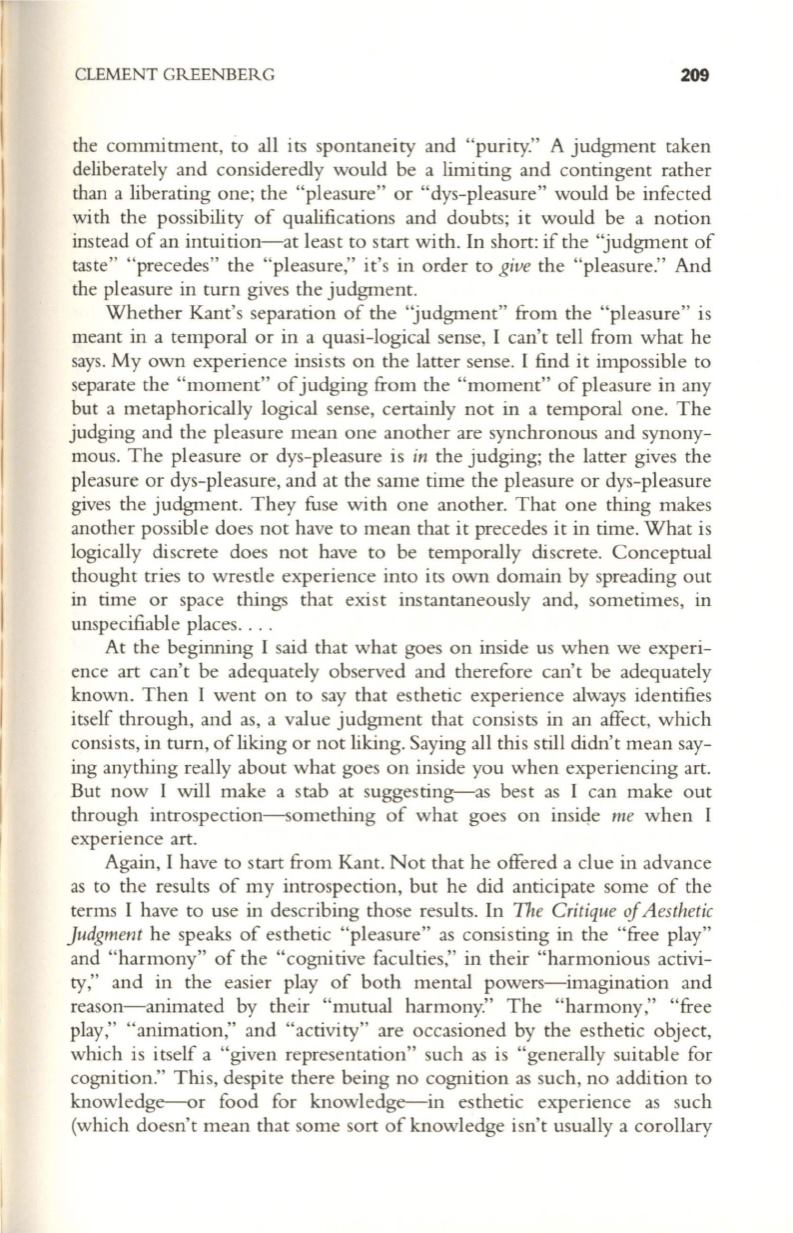
CLEMENT GREENBERG
209
the commitment, to all its spontaneity and "purity." A judgment taken
deliberately and consideredly would be a limiting and contingent rather
than a liberating one; the "pleasure" or "dys-pleasure" would be infected
with the possibility of qualifications and doubts; it would be a notion
instead of an intuition-at least to start with. In short: if the "judgment of
taste" "precedes" the "pleasure," it's in order to
give
the "pleasure." And
the pleasure in turn gives the judgment.
Whether Kant's separation of the "judgment" from the "pleasure" is
meant in a temporal or in a quasi-logical sense, I can't tell from what he
says. My own experience insists on the latter sense. I find it impossible to
separate the "moment" of judging from the "moment" of pleasure in any
but a metaphorically logical sense, certainly not in a temporal one. The
judging and the pleasure mean one another are synchronous and synony–
mous. The pleasure or dys-pleasure is
in
the judging; the latter gives the
pleasure or dys-pleasure, and at the same time the pleasure or dys-pleasure
gives the judgment. They fuse with one another. That one thing makes
another possible does not have to mean that it precedes it in time. What is
logically discrete does not have to be temporally discrete. Conceptual
thought tries to wrestle experience into its own domain by spreading out
in time or space things that exist instantaneously and, sometimes, in
unspecifiable places... .
At the beginning I said that what goes on inside us when we experi–
ence art can't be adequately observed and therefore can't be adequately
known. Then I went on to say that esthetic experience always identifies
itself through, and as, a value judgment that consists in an affect, which
consists, in turn, ofliking or not liking. Saying all this still didn't mean say–
ing anything really about what goes on inside you when experiencing art.
But now I will make a stab at suggesting-as best as I can make out
through introspection--something of what goes on insiqe
me
when I
experience art.
Again, I have to start from Kant. Not that he offered a clue in advance
as to the results of my introspection, but he did anticipate some of the
terms I have to use in describing those results. In
The Critique
if
Aesthetic
Judgment
he speaks of esthetic "pleasure" as consisting in the "free play"
and "harmony" of the "cognitive faculties," in their "harmonious activi–
ty," and in the easier play of both mental powers-imagination and
reason-animated by their "mutual harmony." The "harmony," "free
play," "animation," and "activity" are occasioned by the esthetic object,
which is itself a "given representation" such as is "generally suitable for
cognition." This, despite there being no cognition as such, no addition to
knowledge-or food for knowledge-in esthetic experience as such
(which doesn't mean that some sort of knowledge isn't usually a corollary


